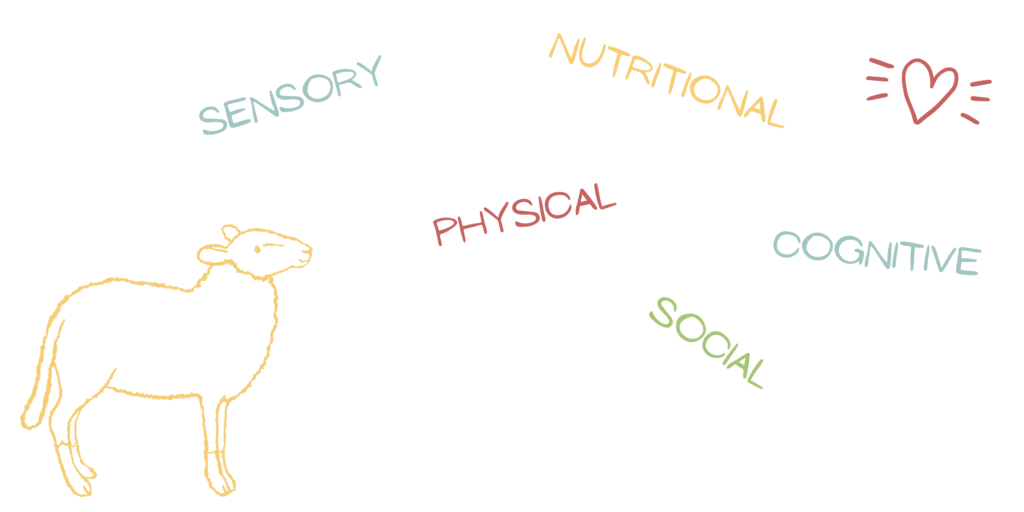
Welcome to the second resource in our Time To Thrive enrichment series! This series is intended to make implementing successful enrichment strategies attainable. To learn more about what enrichment is and why it is important, check out the first resource in our series. In this resource, we will break down the types of enrichment and provide brief examples of each. If you already feel comfortable with the basics of enrichment and are looking for more species-specific tips, you can check out individual resources covering a number of enrichment ideas for different species here. For those of you who would like to learn more about the basics, let’s take a look at the different types of enrichment you can offer residents at your sanctuary.
Different Kinds Of Enrichment
Enrichment is often broken down into 5 categories: Physical or Structural Enrichment, Nutritional Enrichment, Social Enrichment, Sensory Enrichment, and Cognitive Enrichment. What each of these categories looks like in practice will depend on the resident species, the individual‘s needs, and your sanctuaries resources in terms of staff and volunteers, time, finances, public support, space, and access to supplies. Don’t worry! Enrichment can range from simple to complex, and there are many inexpensive options, which we will cover in another resource. Let’s take a look at the different categories!
Physical Or Structural Enrichment
Let’s start with physical or structural enrichment. This form of enrichment considers the environment the individual lives in and what possible enriching aspects of the physical environment exist or can be added to the living spaceThe indoor or outdoor area where an animal resident lives, eats, and rests. to make it more dynamic and engaging for the individual or group. Goats, for example, might thrive more in a physical environment that has multiple food and water areas, large rocks, tree stumps or downed trees (goat-safe), mounds, and elevated structures for standing upon and getting a different view of their environment. Of course, physical enrichment looks different for every species, and can vary greatly among individuals too! For instance, ducksUnless explicitly mentioned, we are referring to domesticated duck breeds, not wild ducks, who may have unique needs not covered by this resource. would likely require very different physical aspects to their environment in order to thrive. This might look like providing an environment that has nesting materials, water features, and duck-safe bushes and grasses. To learn more about creating living spaces designed with residents in mind, check out our animal-centered design resource!

Nutritional Enrichment
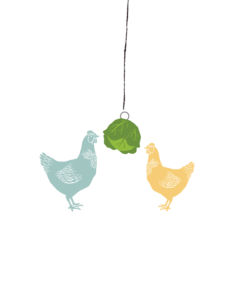
Nutritional enrichment might seem pretty obvious, but there can be a lot to it! Nutritional enrichment might be as simple as the act of providing different appropriate treats to individuals, to more complex strategies, such as hiding food throughout a living space, providing treats in puzzles or manipulatable objects, or in the form of changing the way food is offered, including adding treats to ice molds for summer months. As in other categories of enrichment, the way nutritional enrichment is offered will be different depending on the species and individual. For example, chickens may find pecking at cabbage that has been safely hung from the ceiling enriching, whereas pigs may find rooting for buried treats under the ground, under logs, or in rooting boxes to be enriching! You may have noticed that nutritional enrichment provides exposure to different sights, scents, and textures. This crosses over into sensory enrichment.
Sensory Enrichment
Sensory enrichment seeks to stimulate a sense or multiple senses, creating depth and variety in a resident’s life. Sensory enrichment includes auditory, gustatory, tactile, olfactory, and visual forms of enrichment:
Auditory: Music, vocalizations of other animals, objects that make sounds when manipulated (like bells)
Gustatory: Flavored water, herbs, different types of produce or treats
Tactile: Scratching posts, different types of substrates, balls, anything with different textures or objects that can be manipulated
Olfactory: Spices, strong-smelling herbs, straw smelling of other residents, resident-safe essential oils placed in different areas of a living area
Visual: Changing up the scenery in a living space, TVs, screensavers, performing different activities within view, adding things like pinwheels outside of living spaces for residents to watch
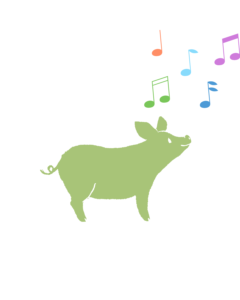
Always Remember The Rule!
You’ll hear us say it many times, but with sensory enrichment strategies, and all other forms of enrichment, it’s only enriching if a resident finds it to be enriching! A resident who is bored, fearful, or upset at proffered enrichment is not having an enriching experience!
Social Enrichment
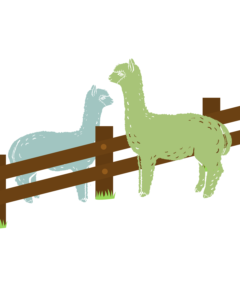
This one may seem obvious, but having access to others is vital for most residents. Sharing a living space with a flock, herd, or even a single companion can make a big difference in their well-being. However, this isn’t the only form of social enrichment! During times of temporary isolation, providing a mirror, playing sounds of others of their species, placing them in a living space where they can see or share a fenceline with their companions, adding straw from their companion’s sleeping area, or providing size-appropriate stuffed animals for isolated youngsters are all ways to provide social enrichment. Social enrichment may include time spent with humans as well, depending on the individual.
Cognitive Enrichment
While all of the above provide cognitive stimulation of a sort, cognitive enrichment encourages curiosity, problem-solving, and learning, and can be quite rewarding for many individuals. Cognitive enrichment creates challenges and provides opportunities for residents to control aspects of their environment, an important aspect of well-being. Examples of this include puzzle feeders, forage boxes, and positive reinforcement learning sessions, like clicker teaching or learning sessions.
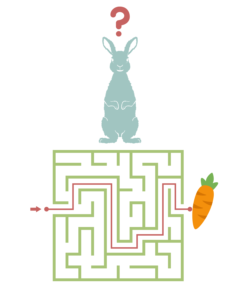
Why Do We Say “Teach”?
At the Open Sanctuary Project, we try to be aware of how language can affect how we see the world and interact with those within it. This has prompted us to choose the word “teach” in place of “train”. This is, in part, due to the association of the word “train” with exploitive human-animal interactions that center human desires. Read more about this and how to approach teaching and learning opportunities with residents here.
The topic of enrichment is an in-depth one. We hope this series will help your sanctuary integrate enrichment into the general care of residents in new and fun ways. To learn more, check out the next resource in our Time To Thrive series, Considering Enrichment For Species And Individuals!
Infographic
Looking for a fun and easy way to share enrichment information? Check out our infographic below!
Enrichment by Amber D Barnes
SOURCES:
The Stimulating Science Of Animal Enrichment | Untamed Science








